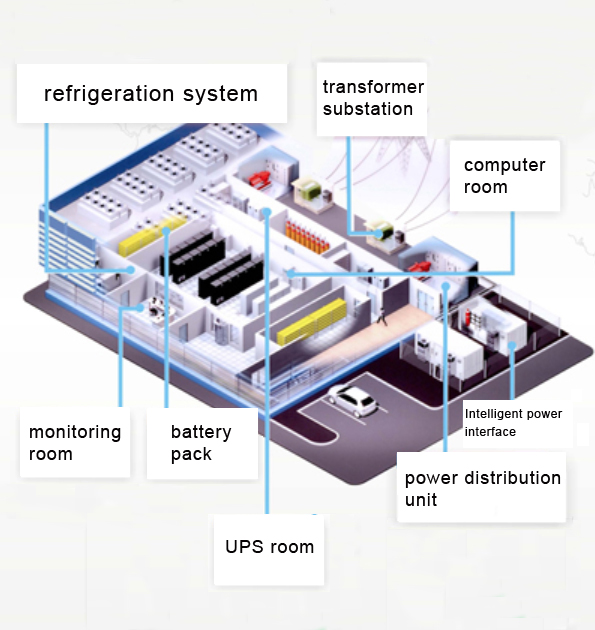
We sincerely look forward to cooperating with you!
Addr:No. 62 South Sanshui Avenue, Sanshui, Guangdong
Tel:0086-18280157343
Fax:0757-87360189
Email:cathy@netion.com.cn,business@netion.com.cn

Focus On Us

The infrastructure system of large data centers is mainly divided into power supply, environmental control, and computer room monitoring and management systems. Due to the high importance of large data centers carrying the core business of enterprises, groups, and institutions, business interruption is not allowed. Therefore, large data centers are generally built in accordance with the Tier 4 standard of the TIA942 standard, with a reliability requirement of 99.9999% or more, to ensure that the data center works normally and core business is not affected under abnormal failures and normal maintenance.
1. The power supply system usually uses multiple municipal power supplies as a backup for each other, and the computer room is equipped with a dedicated diesel generator system as a backup power supply system. The municipal power supply room, the municipal power supply room, and the diesel generator room are switched through ATS (automatic switching switch) to supply power to the UPS (uninterruptible power supply), computer room air conditioning, lighting, and other equipment in the data center. Due to the business importance of large data centers, a dual bus power supply scheme is usually adopted to meet the high reliability power consumption requirements of IT equipment such as large data center servers. The dual bus power supply system has two independent UPS power supply systems (including UPS power distribution system). In the event that either set of power supply buses (power supply system) requires maintenance or fails to supply power normally, the other set of power supply buses can still bear all loads, ensuring the power supply for the computer room business, and ensuring that the data center business is not affected. In the input room of IT equipment such as UPS output to servers, SPM (Server Power Manager) is selected for power distribution and power supply management to achieve power monitoring and management for each cabinet, improving the reliability and manageability of the power supply system. For IT equipment such as servers with dual power supplies, power can be introduced directly from the two buses of the dual bus power supply system through SPM to ensure high reliability in power consumption. For IT equipment such as servers with a single power supply, STS (Static Switching Switch) is usually selected to switch a set of power supply buses for power supply. When the power supply bus fails to supply power normally, STS will automatically and quickly switch to another set of bus with normal power supply to ensure reliable power consumption of IT equipment such as servers.
2. For environmental control systems, precision air conditioners in computer rooms are usually used to regulate the environment of data centers to ensure the operating environment of IT equipment such as servers. For IT equipment such as servers with high heat output, cabinets with high porosity (generally greater than 70%) mesh doors are usually selected to increase the amount of access to the cabinets; Arrange the cabinets face to face and back to back to form cold and hot isolated air ducts in the machine room to improve refrigeration efficiency; The air conditioner adopts a downward air supply method to ensure uniform air supply in the machine room and improve refrigeration efficiency. In some particularly high power density situations (heat generation exceeding 5kw/cabinet), it is often easy to generate local hot spots, forming a potential failure hazard. In order to eliminate local hot spots, it is necessary to adopt corresponding high heat density solutions, such as the open scheme, which is to install refrigeration XD at the place where the local hot spots occur, and strengthen the local cooling capacity to eliminate local hot spots; The closed scheme refers to the placement of high power density equipment in a closed cabinet, which achieves efficient cooling and heat dissipation through refrigeration cycles within the cabinet.
3. Computer room monitoring and management system: Large data centers need to manage the operating status of equipment such as power supplies and air conditioners, as well as monitor the internal environment of the computer room, such as temperature and humidity, water leakage, smoke sensitivity, and other parameters to ensure that the data center operates within a normal range. And real-time monitoring and management of the operating parameters and environmental quantities of the data center equipment, as well as remote monitoring and management, to achieve unattended computer rooms.
1. Electric Power Guarantee System
◆ Single Or Multiple Power Supply System
◆ High/Medium/Low Voltage Power Distribution System
◆ Uninterruptible Power Supply System
◆ Standby Power Generation System
◆ Lightning Protection And Grounding System
2. Air Conditioning System
◆ Constant Temperature And Humidity Air Conditioning System
◆ Comfort Or Split Air Conditioning System
◆ Chilled Water Unit
◆ Fresh Air System
◆ Liquid Cooled Server Cabinet
◆ Refrigeration System Layout And Air Flow Organization
3. Security System
◆ Monitoring System (Including network management system, power remote monitoring system, battery detection system, etc.)
◆ Access Control System
◆ Building Management System
◆ Water Leakage Alarm System
◆ Fire Alarm System
◆ Smoke Exhaust System